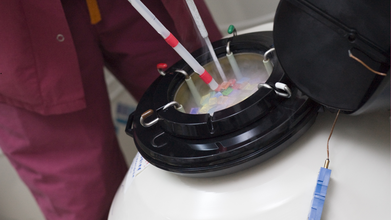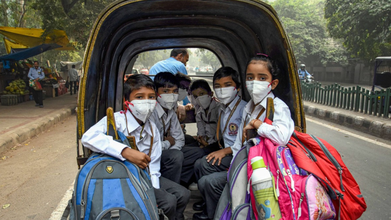- Health Conditions A-Z
- Health & Wellness
- Nutrition
- Fitness
- Health News
- Ayurveda
- Videos
- Medicine A-Z
- Parenting
Are Breastfeeding Mothers More Prone to Depression? Here is What Experts Say

Credits: Unsplash
Breastfeeding rates are similar around the world, however, there are certain barriers breastfeeding mothers face. These challenges differ in developed and developing countries. Dr Avneet Kaur, neonatologist and Pediatrician at the Apollo Cradle Hospital, says that in developed worlds, perceived inconvenience of breastfeeding and ease of bottle feeding, false idea of healthiness in chubby babies, lack of family support and lack of breastfeeding-friendly work environment played a significant role in poor breastfeeding rate.
On the other hand, in the developing world, due to lack of education and poor access to healthcare facilities, “false beliefs regarding breastfeeding being roadblocks to success” is what led to the discouragement of breastfeeding, points out Dr Kaur.
Benefits of Breastfeeding
Dr Kaur points out that both the mother and the child benefit from breastfeeding. “Breastfeeding is associated with decreased rates of lower respiratory tract infections, severe diarrhoea, otitis media, sudden infant death syndrome and obesity in babies,” she says.If there is a lack of breastfeeding, it may lead to health problems for the baby. Some babies may develop medical conditions like postnatal weight loss, dehydration, and fever. “Mother faces issues like mental stress, breast engorgement and delayed emotional bonding,” says Dr Kaur.
Breastfeeding also benefits premature or preterm babies. “Premature babies who are formula fed and do not receive breastmilk are more likely to get a life-threatening bowel condition called necrotising enterocolitis or NEC,” says Dr Kaur.
She suggests that breastfeeding and human milk feeding support optimal growth, improve immune function and neurodevelopment, and prevent bowel and septic complications, including necrotizing enterocolitis in preterm babies.
However, breastfeeding is still not easy for many mothers. Many workplaces still lack provisions for maternity leave, not allowing enough rest for the mother to look after her child. Other factors could be the lack of private space to feed the child and the lack of social, emotional and familial support. This can make the mother prone to depression.
Are Breastfeeding Mothers Depressed?
Right after a child is born, a mother may feel anxious and exhausted, this is called post-partum depression. “It is quite common for breastfeeding mothers to experience depression. Studies suggest that approximately 10-20% of new mothers experience postpartum depression,” says Dr Chandril Chugh, senior consultant neurologist and director of Good Deed Clinics.Dr Chugh mentions the reason for a breastfeeding mother to feel depressed is the lack of support that she receives from her family. “Social support is crucial. Emotional support from partners, family, and friends can help alleviate feelings of isolation and stress. Support groups and professional counselling can also provide necessary emotional backing and practical advice,” he says.
Added Responsibilities
Dr Kaur suggests that breastfeeding must be done as soon as the mother is stable after the delivery. However, without the support of family, a mother may feel that she is doing everything alone.Especially at home, a baby may be required to be breastfed at night, which can disrupt a mother’s sleep cycle, pushing her more towards depression. “Sleep deprivation and chronic fatigue are significant risk factors for depression. The demands of breastfeeding, especially frequent night feedings, can disrupt sleep patterns and contribute to emotional and physical exhaustion,” says Dr Chugh.
However, Dr Chugh also notes that if the mother is given the support that she requires, and the responsibility is shared, then the mother can enjoy the benefits that breastfeeding. “Prolactin and oxytocin levels increase during breastfeeding, which can also influence mood and emotional well-being,” he says.
Taking care of the mother is of utmost importance right after delivery, especially when she is breastfeeding. He suggests that adequate rest and helping the mother with the baby must be the top priority. A mother must not feel alone, and she should be given the support she needs to ensure that she also benefits from breastfeeding.
“Mother should start taking good diet and remain hydrated, get optimum sleep and rest in first 4 weeks to recover in the postpartum period. Stress and inadequate sleep are major hindrances to breastmilk production,” says Dr Kaur.
Leaving mothers alone with her babies discourages the purpose of the breastfeeding awareness week and pushes the mother further into depression.
How Egg Freezing Is Giving Women More Control Over Their Life

Credits: Canva
Upasana Konnidela, during her visit to IIT Hyderabad, as the Vice Chairperson of Corporate Social Responsibility at Apollo Hospitals, she told students: “The biggest insurance for women is to save your eggs. Because then you can choose when to get married, when you want to have kids on your own terms, when you are financially independent. Today, I stand on my own two feet, I earn a living for myself.” However, egg freezing is becoming popular now and has many benefits. It brings emotional comfort to the women planning their future. This procedure has become a growing source of confidence and reassurance for today’s women. In this article, the expert explains what is egg freezing, who is advised it, the benefits. It is time to clear all the misconceptions regarding egg freezing and help women to preserve their eggs for the future use.
Egg freezing, or oocyte cryopreservation has become popular over the years among women who wish to preserve their fertility. So, egg freezing is a process where a woman’s mature eggs are collected, frozen at very low temperatures, and stored for future use. This allows women to use their younger, healthier eggs later in life when they decide the time is right for pregnancy. This procedure is widely chosen by the women now. The process is initiated with hormone injections that help the ovaries produce multiple mature eggs instead of just one. After that, the woman will be regularly monitored with the help of ultrasound scans and blood tests. Once the eggs are ready, they are retrieved and frozen. When the woman chooses to conceive, the eggs can be thawed, fertilized, and used for IVF.
Who should opt for egg freezing: Those women who wish to postpone their pregnancy because of career aspirations, education. Ones detected with endometriosis, autoimmune diseases, or low ovarian reserve. Women with cancer who may have to undergo chemotherapy or radiation. So, it is necessary to consult an expert who will explain to you about this procedure.
The benefits: It tends to offer emotional security to women and give them enough time and freedom to plan pregnancies without the pressure of a biological clock. It improves the chances of having a healthy pregnancy later, using eggs preserved at a younger age.
Facts related to this procedure: Egg freezing helps women preserve their fertility by storing healthy eggs at a younger age, giving them more control over future family planning. Women shouldn’t worry as this procedure is extremely safe, and widely chosen by women and is supported by modern technology that keeps egg quality intact for years. Egg freezing is indeed a boon for women. So, women shouldn’t hesitate and come forward to freeze their eggs.
Here, the expert also debunks myths linked to egg freezing
Myth: Egg freezing is extremely expensive
This is one of the most common misconceptions. Currently, many hospitals offer affordable pricing, EMI options, and flexible packages for women and thus, it has brought a sense of relief for them. As awareness increases, many women are finding that egg freezing is far more accessible than they believed.
Myth: Only rich or celebrity women opt for egg freezing
Many working professionals, teachers, healthcare workers, IT employees, and women from all backgrounds are opting for this procedure.
Myth: The procedure is painful and unsafe
Egg retrieval is quick, done under sedation, and most women return home the same day. Don’t fret as the procedure is extremely safe when done under the skilled expert.
Avoid believing on any false information or rumors related to egg freezing. If planned early and guided by a qualified specialist, it can help women fulfil their dram of motherhood later in life when they are fully ready.
Diabetes Can Also Impact Your Reproductive Health, According To Doctor

Credits: Canva
Diabetes is one of the fastest-growing lifestyle disorders in India, and while its impact on the heart, kidneys, nerves, and eyes is widely discussed, its effect on male reproductive health is often overlooked. To understand it better, the Health and Me team spoke to Dr. Prajakta Chaudhary, Fertility Specialist at Nova IVF Fertility, Andheri. The doctor explained that uncontrolled diabetes can significantly harm sperm quality, sexual function, and hormone balance. “Many men don’t realize that poorly managed diabetes can directly affect their fertility,” she says.
While both men and women are affected by diabetes, a large proportion of men remain unaware that their reproductive health may be at risk. High blood sugar levels, especially when unmanaged for long periods, interfere with the body’s ability to use insulin properly, leading to complications that extend far beyond fatigue, thirst, or frequent urination. Dr. Chaudhary explains that long-standing diabetes can damage nerves, blood vessels, and even reproductive organs, creating a cascade of effects that may impact fertility.
How Diabetes Affects Sperm Health
Uncontrolled diabetes can compromise sperm health in multiple ways. One major concern is oxidative stress, a condition triggered by high blood sugar levels that damages sperm DNA. Dr. Chaudhary notes, “High glucose levels can harm the genetic material inside sperm cells, affecting their ability to fertilize an egg.”
Men with diabetes may experience:
- Lower sperm count
- Reduced sperm motility (slower movement)
- Abnormal sperm morphology (shape issues)
These changes can make conception more difficult. Additionally, diabetes-related nerve damage may lead to erectile dysfunction or difficulty ejaculating, further reducing the chances of successful conception. Hormonal imbalance is another concern, many men with unmanaged diabetes show reduced testosterone levels, impacting libido and overall reproductive function.
“When diabetes remains uncontrolled, we commonly see low testosterone and issues like erectile dysfunction or ejaculation difficulties,” the doctor shares. This combination can significantly challenge a couple’s journey to parenthood.
Steps Men Can Take to Protect Their Fertility
Despite the risks, men can take meaningful steps to safeguard their reproductive health. Dr. Chaudhary emphasizes the importance of consistent diabetes management: “Regular monitoring of blood sugar and keeping it within the recommended range is the foundation.”
She advises incorporating the following habits:
- Take prescribed diabetes medications regularly
- Exercise for at least 45 minutes daily
- Practice stress-relief activities like yoga or meditation
- Maintain a healthy weight
- Eat a balanced, nutrient-rich diet
- Quit smoking and reduce or avoid alcohol
- Go for routine health check-ups
For couples trying to conceive, she recommends adding hormone testing and semen analysis to routine evaluations.
The Last Word
Poorly managed diabetes can impact sperm quality, testosterone levels, and sexual function—but the good news is that these issues are often reversible with proper care. Dr. Chaudhary explains that fertility treatment for men with diabetes typically focuses on stabilizing blood sugar, correcting hormonal imbalances, and addressing sperm-related issues. “Depending on sperm quality, assisted reproductive techniques like IUI or IVF may be recommended,” she adds.
For men with diabetes planning to start a family, early evaluation and timely intervention can make a significant difference. As Dr. Chaudhary puts it, “With proper guidance and blood sugar control, fatherhood is absolutely achievable.”
Should Kids “Learn to Tolerate” Delhi-NCR Pollution? Doctor Addresses Parents’ Fears About Air Purifiers and Immunity

Credits: PTI
Delhi continues to choke, and again wakes up to toxic air on Friday, as the Air Quality Index (AQI) stayed in 'severe' category. As of 8am, the Anand Vihar monitoring station recorded an AQI of 418 as per the Central Pollution Control Board (CPCB). As of 7am, as per aqi.in, Delhi's average AQI was recorded at 455. As of mid-day, around 10am, the AQI was recorded at 303, which is equivalent to smoking 10.3 cigarettes noted aqi.in.
Parents too are now concerned about their children's health. A Delhi resident Akshat Verma, posted on his LinkedIn that his three-year-old son now needs to understand the term AQI. He writes: "One week he’s learning how to hold a pencil... next week he’s learning why he can’t go to school because the air is ‘too poisonous'."
Also Read: Taking Magnesium And Melatonin Together? Here’s How It Affects Your Sleep
Many parents echo the feeling, and many have raised questions too, including if at all an air purifier helps a child as the moment the child steps out, he will be breathing polluted air. Addressing all the questions, Dr Shreya Dubey, who is a leading pediatrician and newborn specialist uploaded a video on her Instagram @anantakidsofficial.
"If we have to stay in Delhi-NCR, then the child should have the habit to tolerate air pollution". "Doctor, if we use air purifier, won't the child's immunity become weak?" These are some of the questions the doctor is asked repeatedly by parents.
Her answer to all these questions is simple: "Air toxicity has nothing to do with immunity."
The doctor explains that if someone is smoking about 30 cigarettes a day, that does not make his immunity better than the one who smokes just 5 cigarettes in a day. The doctor says that exposure to toxic pollutants has no relation with tolerance or immunity building, in fact, longer exposure can cause more damage.
Also Read: China’s ‘Zombie Cell’ Pill Claims To Extend Human Life To 150—Could It Work?
How Can You Protect Your Child Against Delhi's Toxic Air?
The doctor suggests to use air purifier for at least 8 to 10 hours at night so the child's lungs can recuperate. She also suggests that for those who cannot afford an air purifier, they can keep air purifying plants at home. In fact, NASA has compiled a list of indoor plants that can improve indoor air quality. The list includes:
- Spider Plant, that can remove formaldehyde, xylene, and toluene
- Snake Plant, that can remove formaldehyde, benzene, xylene, toluene, and nitrogen oxides
- Peace Lily, that can remove formaldehyde, benzene, trichloroethylene, xylene, and ammonia
- Aloe Vera, that can remove formaldehyde and benzene
- Boston Fern, that can remove formaldehyde and xylene
The doctor also suggests other alternative for an air purifier, which includes wearable purifier for indoor pollution, charcoal bags in child's room, and DIY fan filter boxes.
What Can Exposure To Pollution Do To You?
Chronic pollution exposure aggravates oxidative stress and systemic inflammation. This means, with every breath you take, you inhale a toxic swamp.
As per Pusan National University, long term air pollution exposure actually triggers allergic immune responses in the lungs. Furthermore, a 2022 study published in the International Journal of Environmental Research and Public Health also shows the negative impact on immune system with alarming and harmful air quality.
As per another 2000 study, published by the British Society for Immunology, people living in areas with higher pollution levels show measurably different immune responses than those in cleaner environment.
Air pollution contains toxins like particulate matter, ozone, carbon monoxide, nitrogen dioxide, and sulfur dioxide. It also includes hazardous air pollutants (HAPs), such as lead, mercury, asbestos, benzene, and other volatile organic compounds. When one breathes this toxic and poisonous air the respiratory system bears the initial brunt of it. The pollutants then damage the delicate tissues lining your airways, and disrupts the barrier that normally prevents harmful substances from entering your body. When this first line of defense is compromised, pathogens find it easier to established infections.
© 2024 Bennett, Coleman & Company Limited

